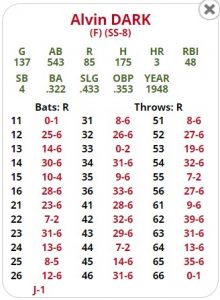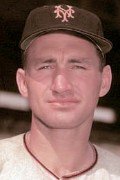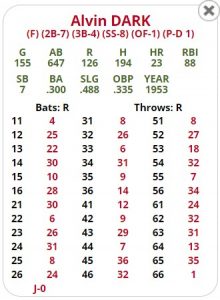
Players like Ted Williams, Joe DiMaggio, and Willie Mays are often mentioned when baseball fans talk about career numbers that were lost because of their service during America’s foreign wars. However, very rarely do fans talk about the players who potentially missed out on the Baseball Hall of Fame because of their service. Alvin Dark has to be near the top of that list.
Only two players in the history of Major League Baseball were Rookies of the Year in both leagues, Jackie Robinson and Alvin Dark. Of course, the first two seasons (1947 & 1948) of the award, only a single player was honored for both the AL and NL. Still, it’s an impressive accomplishment.
Even though Alvin Dark would not become a Hall of Fame player like Jackie Robinson, he was a heck of a player for fourteen seasons. Playing for the Boston Braves, St. Louis Cardinals, Chicago Cubs, Philadelphia Phillies, Milwaukee Braves, and primarily with the New York Giants, Dark was a three-time All-Star and 1948 Rookie of the Year. For his career, Dark accumulated over 2,000 hits and was a .289 career hitter. He hit .300 or better four-time and twice hit over 20 homers. For a 1950s era middle infielder, those are outstanding numbers. When Dark retired in 1960, he had the seventh-highest career slugging percentage and third-most career home runs among NL shortstops.

Alvin Dark was a multi-sport athlete who was a halfback at LSU before serving in the Marines during the Second World War. Even though he never saw combat during the war, the global conflict probably delayed the start of Dark’s Major League career by two or three seasons. After coming up in September 1946 for fifteen games, Dark would spend a year in the minors before breaking in for the Boston Braves in 1948 as a 26-year old rookie.
His first card shows his knack for being a prototypical number two hitter. Dark was an excellent contact hitter, who could hit the ball the other way when needed. He could push a bunt where he liked and was a great hit and run man. Though this card lacks the power numbers that Dark would eventually earn, it is balanced and hits for an excellent average. I project it to hit .321, which is almost exactly what he achieved. The most impressive thing about this card is its FOUR 31s, with only two 13s. This is one of the best basic game hit & run APBA cards I’ve seen.

Al Dark’s best season was in 1953 when he hit .300 on the button with 23 homers and 88 RBI. Those are the kind of numbers modern Major League franchises hope for from their shortstops. The biggest difference with Dark’s card compared to a modern player is that he only has one 13 while earning three 31s. That season was the culmination of four straight years where he was between a five or six WAR shortstop while helping the 1954 New York Giants win the World Series.
Alvin Dark is better known as a manager to many baseball fans. In the early 1960s, he started his managerial career by piloting the San Francisco Giants, modeling his style after Leo Durocher. In later years, he’d skipper the Kansas City Athletics, Cleveland Indians, and San Diego Padres. His most impressive stint as a big-league manager was in 1974 and 1975 with the Oakland Athletics. In 1974 he led the A’s to a World Series championship over the Los Angeles Dodgers. At the time, Dark was only the third manager to lead a team to the World Series in both leagues.
If Al Dark had been able to start his career two years earlier, he easily would have surpassed 2,500 career hits while maintaining close to a .300 career average. In 1966, that was likely a Hall of Fame shortstop. To compare, those numbers are better than Pee Wee Reese’s 2,170 hits and .269 lifetime average. However, baseball history is littered with what-ifs. Alvin Dark is just one of the more intriguing ones.




Great article! I never knew of Alvin Dark’s career. Growing up in the Los Angeles area I only knew of Dark as the SF Giant’s evil manager who dug up the first base area and replaced it with sand to slow down the Dodgers’ Maury Wills.